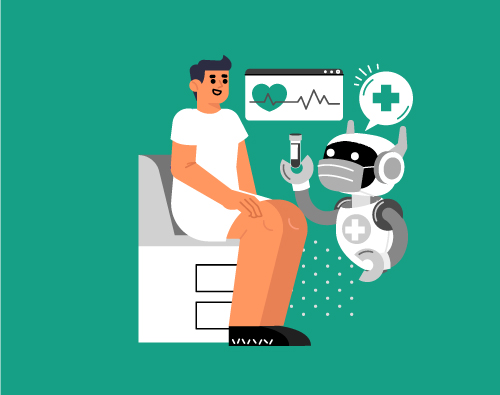Top AI Trends in healthcare


Various innovations in healthcare, is how we find, prevent, and cure diseases have driven the healthcare industry over the last decade. This should not have happened without the massive growth of custom software development and AI-driven technologies and the digitization of healthcare workflows as a response to harsher global conditions and rising demand for accessible and high-quality medical careAs we move forward, it’s critical to keep an eye on the trends that will shape healthcare technology in 2022. Although legacy software and infrastructure are critical to the success of modern hospitals and care centers, we must consider how those systems can integrate with newer technologies or be replaced with more reliable systems in the future. The emphasis should be on increasing performance, productivity, efficiency, and security while not sacrificing dependability or accessibilityIf you’re ready to investigate the technological innovations propelling the healthcare industry toward digital transformation this year, here are the top technologies that have the potential to transform your organization.AI IN DIAGNOSIS & DRUG DEVELOPMENT nnOutside of treating and responding to the pandemic, artificial intelligence has numerous applications. With AI is extremely useful for increasing the efficiency of information processing and decision making. Machine learning is extremely useful in the healthcare industry for the development of new pharmaceuticals and the efficiency of diagnosis processesAI is assisting in the analysis of CT scans to detect pneumonia in those being treated for the effects of COVID-19. Microsoft created Project InnerEye, an AI tool for radiotherapy. This significantly speeds up the patient’s 3D contouring process, reducing completion time to minutes rather than hours. The code for the project is available on GitHub. Another Microsoft AI system, Project Hanover, is designed to catalog biomedical research papers from PubMed. This shortens the time it takes to diagnose cancer and aids in determining which drugs should be used for each patient.
Artificial intelligence advancements are not limited to physical health. Researchers at MIT and Harvard University used machine learning to track trends and mental health in relation to the COVID-19 pandemic. They were able to analyze thousands of online Reddit messages using an AI model and discovered that topics of suicidality and loneliness had nearly doubled over time. This has the potential to transform our understanding of large populations’ mental healthAI can also be used to detect symptoms of illnesses caused by chemical changes in our brain, which result in a variety of mental symptoms. Dementia is one of these diseases. Alzheimer’s disease, which is characterized by communicative, reasoning, and memory problems, is one of the most common forms of dementia. These conditions cause a variety of mental symptoms and can progress for decades without being noticed. Simultaneously, early detection of dementia is one of the most effective ways to treat the disease or, in some cases, reverse the cause of symptomsWith advances in deep learning and AI audio processing, it is now possible to analyze human speech to detect early signs of dementia. Simply put, a speech processing AI model can be trained to distinguish between healthy and dementia-related speech features. Such models can be used for screening or self-checking Alzheimer’s disease, and can detect it years before severe symptoms appear.
Also Read: WHAT IS AWS AND WHY IS IT NECESSARY?
For decades, biopsy was the only reliable method of diagnosing cancer diseases, which involved the extraction of tissue for analysis. This, however, does not provide a complete picture of the organ tissue. Histopathology methods of today rely on digital scans of a specific area that can be affected by cell mutations. Pathologists can examine much larger areas of human organisms at once using whole slide images or Working with WSI appears difficult due to the image’s high resolution. While WSI scans are extremely informative, it takes hours of careful zooming in and out and scrolling from area to area before inspection yields a result. As a result, AI applications that can process WSI using computer vision and convolutional neural networks have emerged. This method assists healthcare professionals by highlighting the region of interest where potential cancer cells can be found, reducing diagnostic timeAccording to the results, the AI approach for WSI analysis not only produces good results but also requires little preparation for model training. Since WSI scanners have become a standard part of medical institutions, this promotes their adoption throughout the healthcare industry.
Chatbots have the potential to improve telehealth efficiency. UCLA researchers combined chatbot technology with AI systems to develop a Virtual Interventional Radiologist (VIR). This was designed to help patients self-diagnose and to aid doctors in diagnosing those patients. Chatbots powered by Natural Language Processing aren’t yet ready to provide primary diagnosis, but they can help. They are also well-equipped to assist patients in gathering information before proper treatment can beginTelemedicine and the Evolution of Remote CarennTelehealth has come a long way since the pandemic began in 2020. Care providers will regularly hold video conference meetings with patients over the Internet in 2022 to discuss concerns and offer advice. The infrastructure for this has greatly improved. By 2026, telehealth is expected to be worth $185.6 billion. With that in mind, what does the future hold?nnAlso Read :n
Before we get into that, one of the most important aspects of telehealth is HIPAA compliance. Although some restrictions were relaxed during the pandemic’s peak in 2020, it is critical for healthcare providers to consider the applications they use to communicate with their patients. Are they safe and qualified to handle sensitive health information?n
In many cases, a more dedicated solution that can specifically adhere to legal privacy requirements is required. WebRTC, an open-source API-based system that connects web browsers and mobile applications and allows for the transmission of audio, video, and data, is one of the most important technologies that will be required if you need a dedicated telemedicine app. This is particularly useful for teleconferencing features.
While most cloud storage services are relatively secure, they are not always compliant with government regulations governing protected health information. HIPAA-compliant cloud hosting solutions are critical for any healthcare operation that requires electronic health records to maintain functionality and efficiency (EVR)However, teleconferencing and data hosting aren’t the only features that could be beneficial to your company. Other potentially useful features include security, location services, appointment management, secure messaging, healthcare provider reviews, visit history, and wearable integrationSome applications may require fitness data from consumer devices like Google Fit and Apple HealthKit. The ability to maintain these integrations in a secure and efficient manner can greatly benefit both the patient and the caregiver.
As the year 2022 approaches, healthcare technology will continue to advance in all areas. Although security will improve across the board, threats are constantly evolving and must be addressed through prevention rather than response. Because of ground-breaking and evolving technologies such as artificial intelligence, machine learning, and extended reality, care quality and efficiency will continue to improve.

In recent years, artificial intelligence (AI) has rapidly advanced, with neural ...
Explore more
In the healthcare sector, safeguarding patient data is not just a regulatory req...
Explore more


D-23, Sector 63, Noida,
UP - 201307

141 Westgate Dr, Edison,
NJ - 08820

4 Black lion court, Mill road, Kent, UK – ME71HL

2207, 2220 Lakeshore Blvd W, Toronto ON- M8V0C1

94A Central Road, Jacanlee, Johannesburg 2194